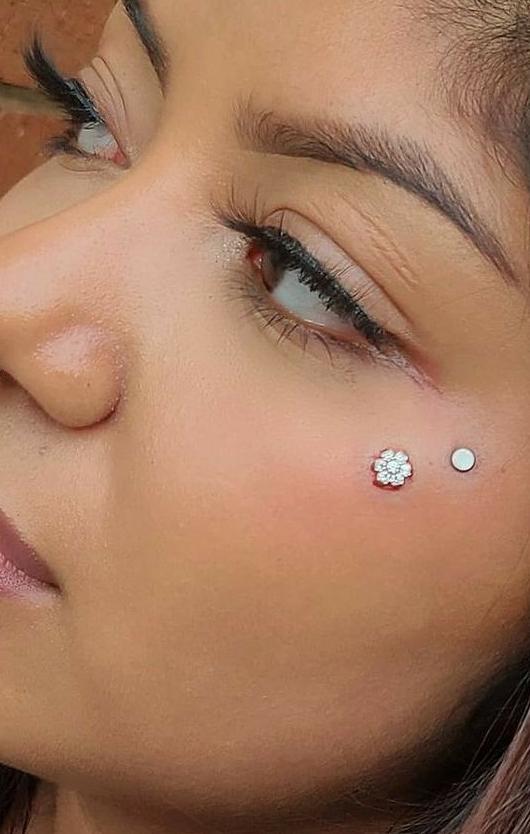
WHAT IS A DERMAL PIERCING?
Dermal piercings are piercings that lie flat against the surface of the skin. The completely flat effect occurs because dermal piercings don’t have a separate entry and exit point, instead a dermal anchor is installed directly under the skin. A small hole is created by a needle or a dermal punch. Then the anchor is inserted under the skin. A jewel is then screwed into the top of the anchor. We use only surgical steel jewelry to minimize any allergic reaction to the piercing. No need to set up an appointment , we welcome walk-ins during business hours. Call the shop if you have any questions regarding price and availability.
AFTERCARE
When the piercer is done screwing the top on, He/she will place a bandaid on top to hold in place and prevent accidentally snagging the jewelry. Keep a bandaid on for 7 days, and change it daily. You take care of a dermal piercing the same way you would a regular piercing. Spray or soak your dermal piercing with saline solution, once or twice a day.
Wash your hands with antibacterial soap before touching the area.
Use a new paper towel each time you clean the piercing.
Clean twice daily with a sea salt or saline solution.
Gently wipe away any crust that’s formed between cleansings.
AVOID THE FOLLOWING:
Wear tight clothing around the piercing.
Allow your hair to get tangled in the jewelry.
Play high-impact sports or engage in other activities where collision is possible.
Submerge the pierced area in a bath, pool, or other body of water.
Use antiseptics or antibacterial soap to clean the piercing.
Rub the surrounding area with a towel. Pat dry instead.
Pick off any crust that forms around the piercing.
Play with or remove the jewelry.
SYMPTOMS TO WATCH FOR:
While mild swelling and crustiness is normal for any new piercing, other symptoms could indicate more severe health concerns.
See your piercer if you experience any of the following signs of infection or rejection:
severe pain
severe swelling
skin that’s hot to the touch
yellow or green discharge
foul odor
rash
With rejection, you may also experience:Jewelry displacement is jewelry that hangs or droops instead of sitting flat on the surface of the skin
transparent or calloused skin around the jewelry top
complete anchor dislodgement
How long will a healed piercing last?
There’s no real timeline for a dermal piercing. However, your skin will eventually grow and push the anchor up to the surface until it falls out. Whether this happens within the next three months or three years depends on how well you care for the piercing.
HOW TO CHANGE YOUR JEWELRY TOP
Once your dermal piercing has completely healed (about three months), you’ll be in the clear to change the external jewelry top. It’s best to have your piercer do this so you can avoid complications, such as accidental anchor dislodgement.
If you do decide to change the jewelry top yourself, carefully follow these steps:
Wash your hands with antibacterial soap before touching the area.
Clean the area with a sea salt or saline solution.
Pat the area dry.
Unscrew the existing jewelry top in a counterclockwise direction. If the top is stubborn, you may need to see your piercer. Your piercer can use forceps to help unscrew the jewelry.
Screw on the new jewelry top in a clockwise direction.
Clean the area again and carefully pat dry.
REMOVING YOUR DERMAL PIERCING
If you need to retire the dermal piercing, see your piercer for professional removal. You should never attempt to remove this type of piercing on your own.
Your piercer will likely:
Clean the area with a sterile solution and pat the area dry.
Unscrew the jewelry top.
Massage the surrounding skin to help dislodge the anchor.
Use a scalpel to make a small incision relative to the size of the anchor base.
Use the scalpel to remove any scar tissue that has formed around the anchor.
Use forceps to pull the anchor out of the skin.
Apply a suture or bandage to the area.
Although a general practitioner or cosmetic surgeon may be able to remove the dermal, you should talk to your piercer before moving forward with removal. They can discuss the pros and cons of having an outside party remove the anchor and may be able to make a referral, if needed.
ENJOY YOUR DERMAL PIERCING!